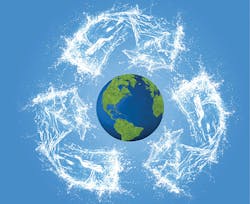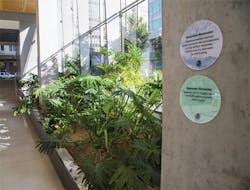One only needs to look at the recent California drought or the ongoing 19-year-long megadrought of the American Southwest to understand why water resource management is essential for populations to survive and thrive.
Water conservation campaigns have urged the preservation of this precious resource, but there’s another tool in the toolbox that water managers are using to extend resources in a safe and effective manner: water reuse.
Some US states have embraced extensive water reuse in addition to water conservation and efficient management in order to avoid wasting water. Technology has made the job of managing water reuse more efficient and easier, but the task is still far from easy. From developing new projects to managing current operations, staff who manage water reuse are keeping on the cutting edge of technology to help protect their area from the impacts of water scarcity.
Will Reisman, press secretary for the San Francisco Public Utilities Commission, which provides drinking and wastewater services to San Francisco and several surrounding counties, says the opportunity to reuse water from sources other than their reservoirs has made it possible to stretch water supplies and avoid unnecessary waste. San Francisco receives the majority of its water from the Hetch Hetchy Valley in Yosemite National Park via a water rights agreement that stems back to the 1930s after the Tuolumne River was dammed in order to flood the valley and create a reservoir for the city.
“As utility leaders, city officials, and the general public embrace innovative, integrated, and inclusive approaches to water use, the opportunity to utilize alternative water sources … for non-potable uses is great,” he says.
Reisman says the ability to use various water sources such as rainwater, stormwater, foundation water, blackwater, and greywater for non-potable uses has made it possible to preserve potable water to be used as drinking water.
A lot of water reuse involves creative thinking in order to find ways to preserve potable water for situations where recycled water isn’t a healthy choice, he says. But there’s no need for used water to go to waste.
Bob Rebori, president of BioMicrobics, a wastewater treatment system supplier based in Lenexa, KS, agrees, adding that “the hurdles are both regulatory and mental.”
He says regulators want solutions that are sustainable, safe, and reliable. One hurdle is that customers see reused water as dirty, even though nearly all available water is reused at some point, often via an upstream customer base.
“So from a mental aspect, many people seem to accept reuse of greywater but have more difficulty with reuse of black and greywater,” he says. “So repeated and verifiable third-party testing over a long period helps overcome some of these issues.”
Public perception can be tough to overcome, but once that hurdle is cleared, having the public on your side means water reuse projects can spread across your community, says Christopher A. Weiss, vice president and discipline director for wastewater engineering for H2M, a consulting and design firm that specializes in water and wastewater facilities, among other specialties.
“Public perception and acceptance has been excellent for reuse water applications,” he says. “The main hurdles are lack of existing infrastructure to allow for the conveyance of reuse water to locations that would benefit from the resource. This lack of infrastructure requires additional conveyance systems be installed to direct the reuse water to the end-users from the treatment facility source, and this can be very costly.”
The popular term “toilet-to-tap” hasn’t done the water reuse industry any favors either. Changing public perception may include adding new lexicon to the public consciousness, like “reused,” “reclaimed,” and “recycled” water—basically, avoiding any association with commodes.
Other terms abound, depending on the conveyance methods and ultimate destination of that water. “Direct potable reuse” is used to define wastewater that is treated to drinking water standards and reused as potable water. “Indirect potable reuse” is water that’s treated to drinking water standards then deposited into a water reservoir, such as a lake or pond, or sometimes used to recharge an underground aquifer. That water is later pumped out, sent back to a water treatment plant, and treated to drinking water standards again to remove anything that got into the water while it was part of that natural environment.
Weiss agrees that regulations can also be a challenge, such as navigating health department restrictions that can be cumbersome and complex. He says the concept of extensive water reuse is new enough that some health departments have limited experience with reuse systems, which can delay the process.
“Regulatory agencies are becoming amenable to adjusted water quality limits, based on the type of water resource reuse application intended, so that all reuse water does not have to be treated to the highest quality level for non-contact applications,” he says.
Mehul Patel, executive director of operations for the Orange County Water District, says one of the main regulatory challenges is a lack of standard rules around the practice of installing and maintaining water reuse projects.
“In my opinion, the main hurdle is a lack of national, cohesive regulations governing the use of recycled water,” he says. “Individual states have established some regulations that have allowed for reuse to be implemented, particularly in California, Texas, and Florida. Another hurdle is a lack of real-time online sensors to detect the presence of pathogens such as bacteria, protozoa, and viruses. Current sensor technology provide[s] an indirect, surrogate-based approach.”
Financing these projects can also be a challenge, Weiss says, especially since water reuse projects tend to cost a bit more than traditional wastewater projects due to the extra treatment cost.
Getting a project off the ground requires “searching out water resource and water quality funding opportunities to help finance the system and infrastructure needed to bring water resource recovery potential into a project,” says Weiss.
If a reuse facility can’t be built from scratch, some municipalities turn to existing water treatment plants, he says. However, these existing facilities don’t treat to reuse quality level, so they require additional steps and systems to get the water to that required level of quality. This adds to the cost of treatment. At the same time, it can save end-users money if reuse water pipes are laid at the same time as new wastewater or potable water lines.
“Consideration for infrastructure to be installed for potential reuse water conveyance at the same time [that] wastewater conveyance or potable water distribution lines are being installed [could] provide the opportunity to connect end-users to resource recovery facilities,” he says.
Reisman says reusing all types of water is possible, but not every type of water will be useful for every water need. Sorting out what types of reused water can be used for various needs helps boost the in-situ efficiency of that water.
Water that can’t be retreated—either because the facilities don’t exist or because the level of contaminants are beyond a facility’s ability—can still be used. For example, mildly treated wastewater is often used for landscaping (some types of grass used on residential lawns even seem to thrive on the nutrient-rich water) and is pumped through cities in well-known “purple pipes.”
“Water that we normally let run down our drains or through our streets into receiving waters has untapped potential to meet non-potable needs such as cooling buildings, irrigating landscapes, flushing toilets, and offsetting valuable potable water supplies,” he says. “The key is applying the right water for the right use.”
One way to do that is through onsite non-potable water systems, Reisman says. These systems are typically included in a city’s water and wastewater systems to help manage various types of water sustainably.
“Onsite non-potable water systems are changing the way we think about applying the right water supplies for the right use,” he says. “Onsite non-potable water systems collect wastewater, stormwater, rainwater, and more, and treat it so that it can be reused in a building or at the local scale for non-potable needs.”
Changing methods for toilet and urinal flushing from potable water to non-potable water has replaced about 25% of the total potable water use in residential buildings, as well as 75% of potable water use in commercial buildings, which have more need for water for purposes other than drinking or cooking, he says.
Reisman says non-potable water can also be used to replace potable water for irrigation (in some cases like grass and resilient plants—other plants and trees like redwood trees don’t tolerate the high salt levels in reused water very well), cooling and heating applications, process water, and washing clothes. “Using onsite non-potable water systems to meet these demands can further reduce potable water demands by 50% to 90%,” says Reisman.
What about technological improvements? What have research and development teams been able to create to expand this method in order to keep up with (and encourage) demand?
Some improvements are enhancements of existing filtration methods or refab methods to help existing facilities take on water reuse needs, albeit at price points that are getting cheaper as the products become more efficient and demand increases.
Advancements include new types of membranes, new types of filtration systems that can handle smaller particles, and new types of secondary equipment that help with monitoring and data collection necessary for adjusting the process to keep the reused water at specific state and federal standards. This data collection stream also helps researchers with their quest to find better methods, regulators as they wade into this emerging field, and legislators if they decide to put parameters around water reuse and water recycling.
Rebori says some new resources like low-cost and low-maintenance screens and filters are popular options for water reuse, but a higher level of filtration and disinfection is required after using water for washing and flushing toilets.
“With waste water treatment and reuse, the same things as above are applicable,” he says. “The emergence of membrane bioreactors allows for a much higher level of filtration from the residential to municipal and industrial applications. Most often it is ultrafiltration membranes with a 0.03 micron pore size which also removes most viruses.”
New types of membranes have made water reuse more efficient and more prolific, as have advances in monitoring equipment and water recharge systems, Weiss says.
“Ultraviolet systems, membrane systems, and microfiltration system advancements are continuing to become more efficient and less costly,” he says. “Easier-to-maintain and less-costly, non-contact shallow irrigation and water recharge systems are coming to market to allow for more options for the application of reuse water in place of irrigation water at more private and public installations.”
He says the main technologies being used today are membrane and microfiltration systems that remove solids from the wastewater and ultraviolet disinfection systems that eliminate viruses and bacteria from reused water. He adds that advanced in-line monitoring equipment that evaluates turbidity and UV intensity have also been helpful technologies because they aid in maintaining the quality of reused water.
“Engineering has been focusing on including treatment systems on new and upgraded systems that bring the effluent wastewater to reuse-ready quality so that either only ultraviolet treatment is needed or ultraviolet treatment and microfiltration are needed to complete the reuse system potential,” he says. “In some cases, we have been able to add membrane treatment with UV disinfection in the base treatment system so that reuse-ready water is available once an end-user is determined.”
Patel says there’s substantial research ongoing to find new and improved water reuse treatments. He says this research could be used one day to establish future regulations, and the Water Research Foundation and the National Water Research Institute are overseeing this research and its implementation.
“There is a lot of work in terms of research that is going on currently to address key issues of concern for a greater implementation of reuse,” he says. “These research projects are trying to fill the knowledge gaps that remain in terms of treatment process reliability, online sensor technology, and water quality characterization with advanced water treatment technologies.”
A few additional technologies are also part of today’s water reuse market: reverse osmosis, ozone, biologically active carbon (BAC), and ultrafiltration—which is differentiated from microfiltration—says Patel.
“Membrane technologies have been key to the success of most of the existing large-scale reuse projects, particularly those classified as indirect potable reuse applications,” he says. “These technologies have allowed for indirect potable reuse to move forward and regulations supporting its implementation to be established in several states.”
Some other technologies are used with current and new membrane technologies to enhance their performance. “This includes carbon nanotubes, nanomaterials, and potential chlorine-tolerant polymer-based membranes,” says Patel.
Reisman says drought-abatement and drought-avoidance methods like water reuse have taken off in California as a new way of thinking about water resources. San Francisco initially changed its health code in 2012 to allow for non-potable water use within the city, and by 2015 non-potable water systems became a requirement for new development projects over 250,000 square feet.
“What originally began as a response to drought-driven conservation needs in urban cities, onsite non-potable water systems have increasingly gained interest as an element of long-term, resilient, and sustainable water supply planning,” he says. “Other benefits can include stormwater pollution reduction, extending the capacity of existing infrastructure, potential reduction in energy consumption and greenhouse gas emissions from collecting and treating water at the source, and environmental stewardship.”
New technologies and new ideas are as important as longtime, reliable suppliers who provide these new resources and are committed to environmental stewardship and cost efficiency, Rebori says.
“It is not just good products that they seek, but suppliers with good people and policies that can help them design solutions to water needs,” he says. “The biggest [advancement] is simple, low-cost, and robust technologies allowing infinite water reuse mostly with MBRs. There is a white paper about a small winery that saved 1.3 million gallons in one year! Imagine if that is extrapolated to many other applications such as washing the floors of big box stores on the third shift, make up water for cooling towers, and so forth.”
Here is an elaboration on several types of technologies experts discussed above that are used in today’s water reuse industry:
- Membrane bioreactors: These are a combination treatment of suspended growth biological treatment along with membranes for filtration, according to the American Membrane Technology Association. The biological treatment is typically activated sludge. The two most common methods of utilizing a membrane bioreactor are gravity-based/vacuum systems and pressure-based systems.
- Membrane microfiltration: A type of semi-permeable membrane that removes particulate matter from water. Microfiltration can remove solids with atomic masses as small as 105 daltons. This typically removes bacteria between 0.1 microns and 10 microns, as well as other non-dissolved matter in this size range. Water is forced through the membrane under pressure, and the matter that doesn’t make it through the filter is removed from the system. Membrane microfiltration is often used as a pre-treatment step for other types of membrane filtration, including ultrafiltration, nanofiltration, and reverse osmosis—although cost sometimes prohibits a municipal water treatment facility from possessing all four of these membrane filtration processes.
- Membrane ultrafiltration: Similar to microfiltration, this is a type of semi-permeable membrane that removes particulate matter from water. Nanofiltration can remove solids with atomic masses between 103 daltons and 105 daltons. This has become a more common type of filtration method in water treatment facilities due to its demonstrated success in removing disease-causing parasites like Cryptosporidium and Giardia. It is sometimes used as a pre-treatment step before the water is sent to fine-mesh membranes like nanofiltration and reverse osmosis.
- Membrane nanofiltration: Another type of semi-permeable membrane that removes particulate matter from water. Nanofiltration can remove solids with atomic masses between 102 daltons and 104 daltons. Pressure forces water through the membrane to remove about half or more of particulate matter. This helps soften water, remove organic material, and get rid of some dissolve solids.
- Reverse osmosis: This is a type of semi-permeable membrane with an even finer mesh that removes particulate matter from water. Reverse osmosis can remove solids with atomic masses as small as 102 daltons. The process can be used to deionize water, remove minerals (including salt, so it is also used with desalination processes), and remove extremely tiny pieces of organic matter. Because the membranes used have such tiny holes, water must be pretreated before it can be run through a reverse osmosis system.
- Ultraviolet light treatment: This is a form of disinfection where ultraviolet light is used as a germicidal system to kill many types of bacteria, viruses, molds, protozoa, and yeasts. The short-wave radiation is lethal to these microorganisms and offers a non-chemical method of disinfection (although chemical disinfection may also be necessary based on the type of water quality one hopes to achieve). Different microorganisms can withstand different ultraviolet light levels, but UV light can kill bacteria that cause diseases harmful to humans such as anthrax poisoning, dysentery, typhoid, and botulism.
- Ozone: Ozone is dissolved into the water being treated onsite by mixing it thoroughly so the ozone gas dissolves properly. It quickly kills bacteria and is a non-chemical, green option for disinfection since it doesn’t produce any waste products. Ozone is created onsite (it can’t be stored) by running a strong electrical current through oxygen, creating O3. Because it is a powerful oxidant, it has been used extensively for drinking water treatment in Europe and is slowly gaining traction in the US as the cost of ozone declines and water treatment standards nationally increase in rigor.
- Biologically activated carbon: Biologically activated carbon systems are a combination of ozone disinfection and granular activated carbon (GAC) systems. Activated carbon is used to separate dissolved organic matter from water being treated. Granular activated carbon has been used in water treatment plants for several decades, but biologically activated carbon systems are newer due to the introduction of ozone disinfection technology.


